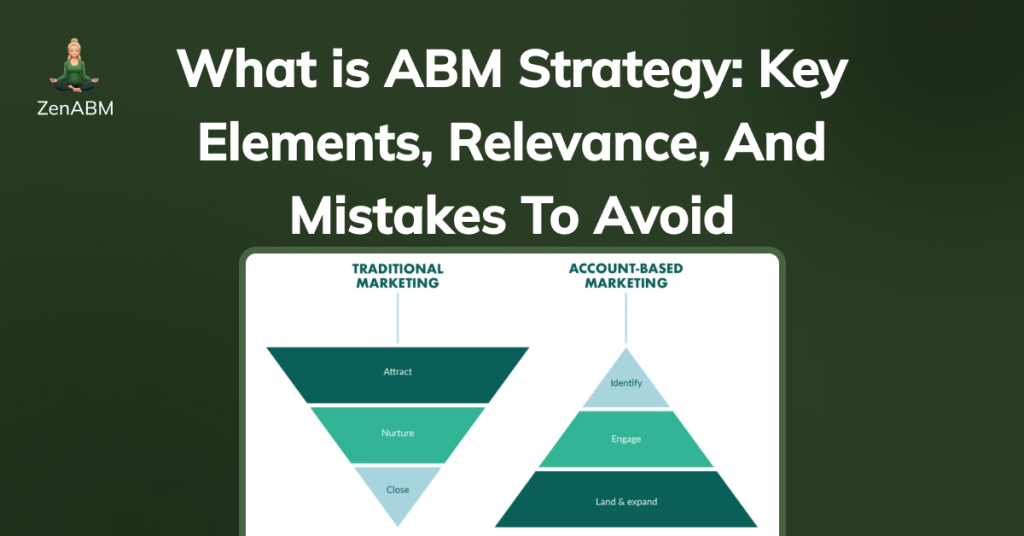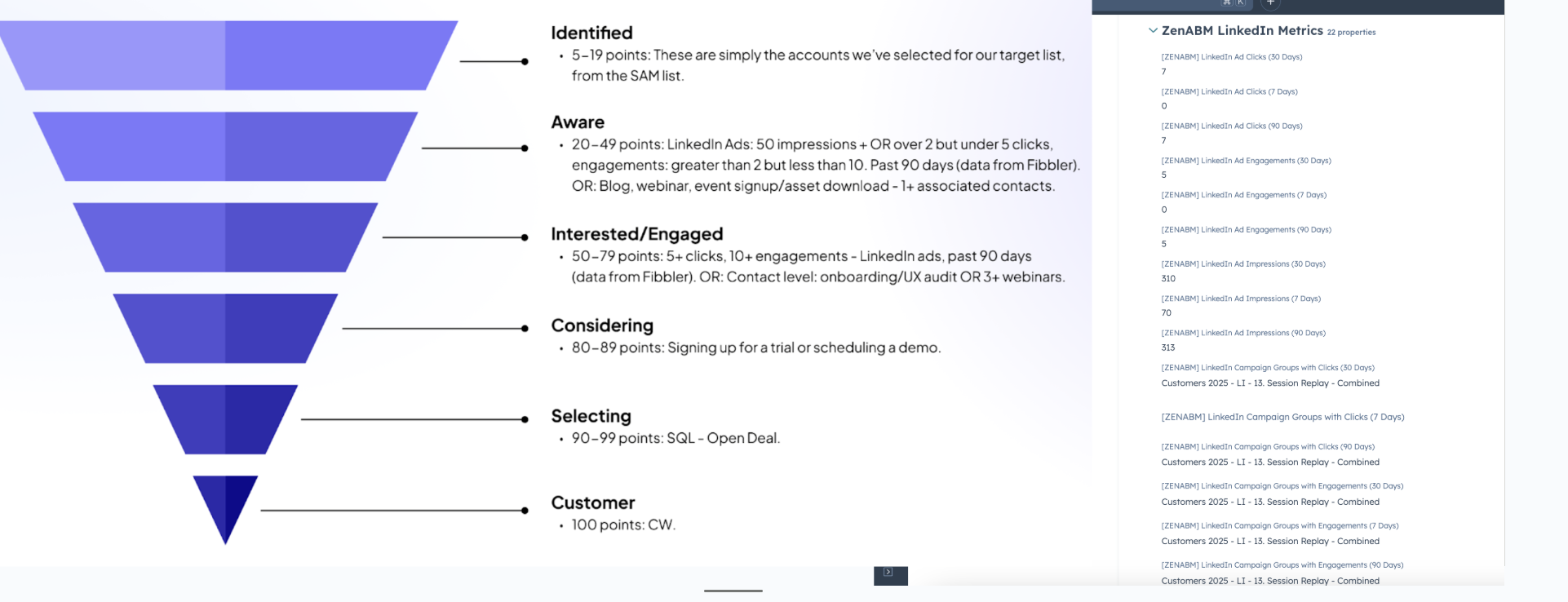ABM strategy is a marketing method that treats individual target companies as markets of one.
Instead of throwing marketing efforts here and there and hoping to catch some leads, ABM strategy is creating a list of accounts (companies) that fulfil the ICP criteria and marketing to them with utter precision and personalization.
The marketing funnel gets flipped here:
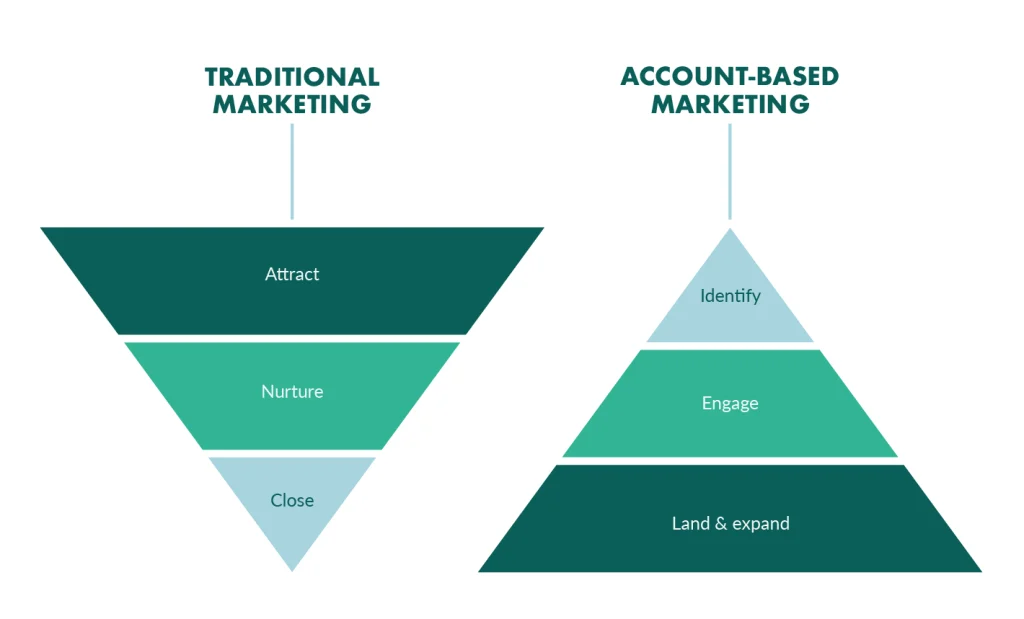
This being the surface definition, let’s get into the thick of what an ABM strategy is (i.e. its key elements), its relevance for today’s B2B world, and mistakes to avoid (plus, how ZenABM can help you nail it).
What is an ABM Strategy: Quick Overview
- ABM flips the funnel: Start by selecting ideal accounts, then engage them with highly personalized campaigns.
- Modern B2B buying is complex: ABM helps influence all stakeholders, not just individual leads.
- Higher ROI: ABM typically results in bigger deal sizes and better resource allocation.
- Sales and marketing alignment is critical: Both teams work on shared goals and account lists.
- Personalization is mandatory: Generic messages no longer cut it. ABM matches outreach to real account context.
- Metrics should be account-centric: Track engagement and pipeline progress at the account level, not by leads or MQLs.
- Tech matters: Use tools like ZenABM to track LinkedIn ad engagement, sync with your CRM, and route accounts based on intent.
- Common mistakes to avoid: Don’t focus on leads, over-segment, or rely on contact-level attribution.
- ZenABM simplifies execution: Get precise company-level data, engagement scores, CRM sync, and leak analysis in one platform.
Why ABM Matters Today, Especially for B2B
ABM is a winning strategy for most B2B ventures because:
Multi-Persona Deals and Longer Cycles

B2B buying was never easy. But now it’s harder than ever.
Decisions that used to involve one or two people now go through gauntlets of stakeholders.
An average of 6 to 10 people sit on modern buying committees, each with their own priorities.
Traditional lead-gen struggles here: you might attract one contact, but miss the other nine who influence the deal.
ABM nails it in this reality by engaging multiple decision-makers at a target account with relevant, coordinated messaging.
It’s ensures your story reaches the CFO, the IT director, and the end user champion all at once.
Higher ROI and Bigger Deal/ACVs.
ABM has also been seen to have a higher ROI and bring bigger deals (one analysis showed a 20% higher average deal value versus traditional marketing).
ABM focuses your resources where they can yield the greatest return: those strategic accounts with big budgets and needs you can uniquely solve.
Rather than scattering budget on hundreds of random leads, ABM lets you double down on a curated list of prospects with the highest revenue potential.
Alignment of Sales and Marketing
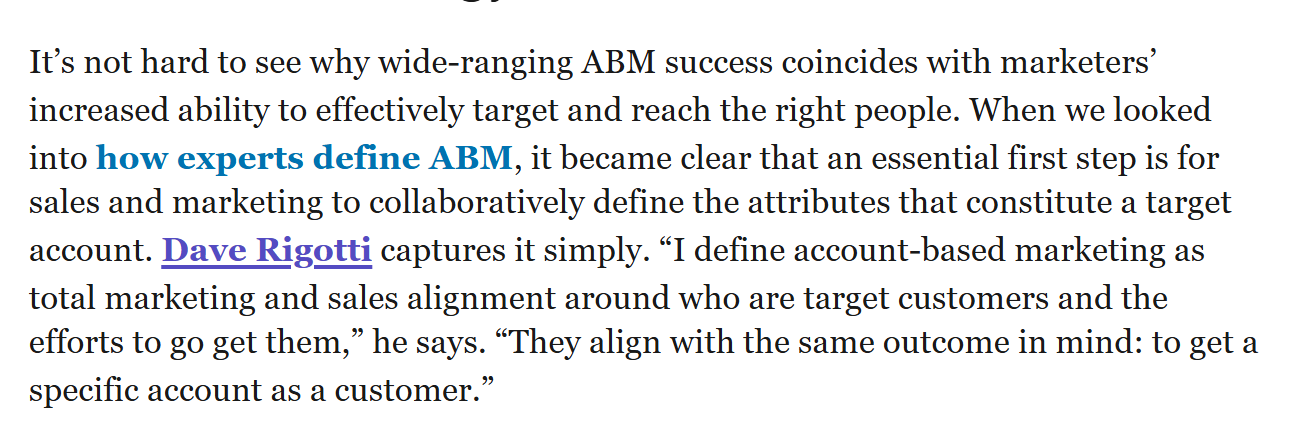
In many organizations, marketing and sales historically operated in silos,.
Marketing throws leads over the wall, sales complains they’re junk.
ABM fixes that because both teams identify target accounts together, agree on personalized plans, and work in lockstep on the same goals.
Also, attribution in ABM is clearer. Instead of attributing credit for one lead here or there, the focus is on revenue from target accounts as a whole.
Adaptation to Buyer Experience Expectations
Today’s buyers expect personalization.
Generic emails and one-size-fits-all pitches get ignored.
ABM is built around outreach that addresses each account’s context – their industry, their specific pain points, even their company’s trigger events.
That level of relevance isn’t just appreciated, it’s now required to break through the noise.
In short, ABM matters because it aligns perfectly with how modern B2B buyers make decisions: through consensus, with high expectations, over long journeys that reward patience and precision.
Key Elements of an ABM Strategy
Let’s look at the key elements of a solid ABM strategy:
Clear ICP and Target Account Selection
Everything starts with defining your Ideal Customer Profile (ICP) – the firmographic, technographic, and behavioral traits that make a company a perfect fit for your solution.
Use data to identify accounts that match this sweet spot.
Rather than targeting 10,000 random companies, you might focus on 50 or 500 that really look like your next best customer.
Many teams tier their target lists (e.g. Tier 1: top 20 strategic accounts for one-to-one focus; Tier 2: next 100 for one-to-few campaigns, etc.).
The key is being intentional about who you target and why.
In fact, SaaS founders like Dmitri suggest that ICP research not just helps with building a great TAL, but also enhances your entire GTM motion:
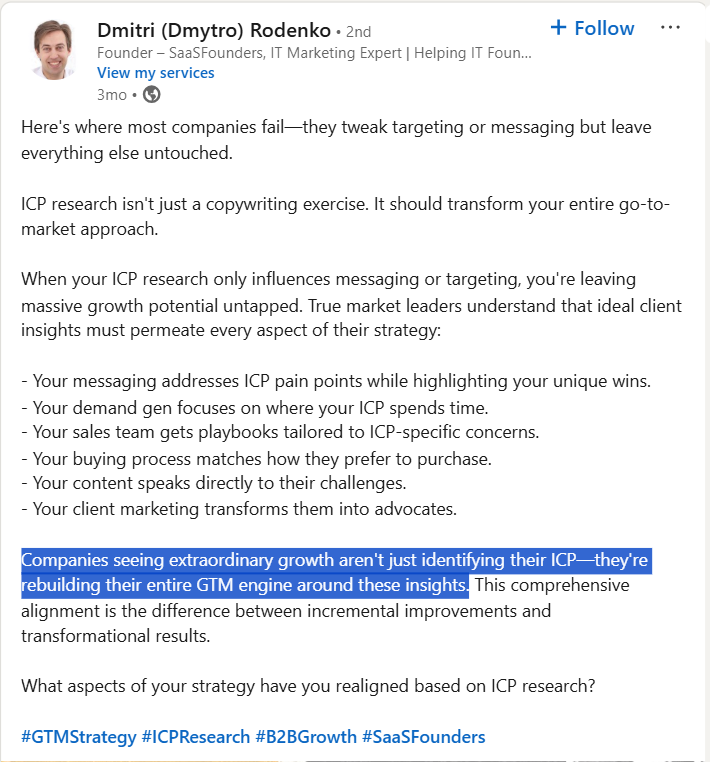
Sales and Marketing Alignment and Collaboration
We discussed how the alignment of marketing and sales is a great outcome for ABM.
But guess what, you have to do it consciously too during your ABM campaigns.
Sales and marketing alignment is both a desirable outcome and a fundamental prerequisite of ABM.
Personalized, Multi-Channel Engagement
A good ABM must address each account’s specific traits, like pain points and industry.
This goes beyond adding a company name to an email.
Good ABM content and campaigns speak directly to each account (or clusters of similar accounts).
Now this could mean custom landing pages addressing a prospect’s use case, ads referencing their industry, or niche events/webinars.
And you should deliver these messages across multiple channels (LinkedIn ads, email, content syndication, direct mail, webinars, even phone calls) to surround the buying team.
The idea is to be where your targets are and hit them with resonant messages from all sides.
Account-Centric Metrics and Measurement
Traditional lead metrics (like individual MQL counts) can be misleading in ABM:
What matters is engagement and progress at the account level.
Strong ABM programs establish metrics like “percentage of target accounts showing engagement this quarter” or “pipeline generated from target accounts.”
For example, instead of counting form fills, you might track how many target accounts had 3+ key people visit your site or click an ad.
One recommended approach is to set funnel stage goals for your target accounts – e.g. X% of targets reach “engaged” (multiple touches), Y% request a demo or enter pipeline, Z% close-win.
This gives a clearer view of whether you’re actually penetrating those accounts.
It’s also important to use account-based attribution: credit the campaign for deal influence if any contact from the target account engaged, not just the person who filled out a form. (In fact, using only contact-level attribution blunder, as we’ll discuss later.)
Technology and Data Insights
While ABM is a strategy, you’ll likely lean on some tools to execute at scale. Common components of an ABM tech stack include a CRM (for tracking account activity), marketing automation, and an ABM platform or analytics tool for account insights.
For instance, here’s the tech-stack they used at Userpilot for their debut ABM campaign that bagged over $900,00 in pipeline at an ROI of $8 in pipeline per $1 spent:
| Requirement | Tool(s) | Purpose |
|---|---|---|
| CRM & Automation | HubSpot CRM + Marketing Hub | Centralize touches and align teams. |
| Sales Outreach | SalesLoft · Apollo | Automated cadences for engaged accounts. |
| List Building & Signals | Clay · BuiltWith APIs | Domain enrichment & tech-stack triggers. |
| Project Management | Notion | Track assets, deadlines, and launch plans. |
| ABM Analytics & Intent | ZenABM |
|
Common ABM Mistakes to Avoid (Lessons from a *Real Story*)
We discussed the tool stack they used at Userpilot in the previous section and their impressive success metrics.
But here are some mistakes they made so you won’t:
Mistake 1: Chasing Leads Instead of Accounts
ABM newbies often cling to old lead-gen mindsets. They set an ABM campaign goal like “generate 100 MQLs” or push prospects to sign up for a webinar, thinking any lead is progress.
The reality: a single webinar signup from a target account doesn’t equal buying intent (it’s a vanity win).
And the solution?
Shift your focus to account engagement, not one-off leads.
Measure success by how many target accounts are moving forward.
Userpilot team, for instance, flipped the KPI to % of target accounts that reach stages like Interested → Considering → Selecting → Closed-Won.
And the specific stage thresholds were inspired by Kyle Poyar’s ABX stages framework:
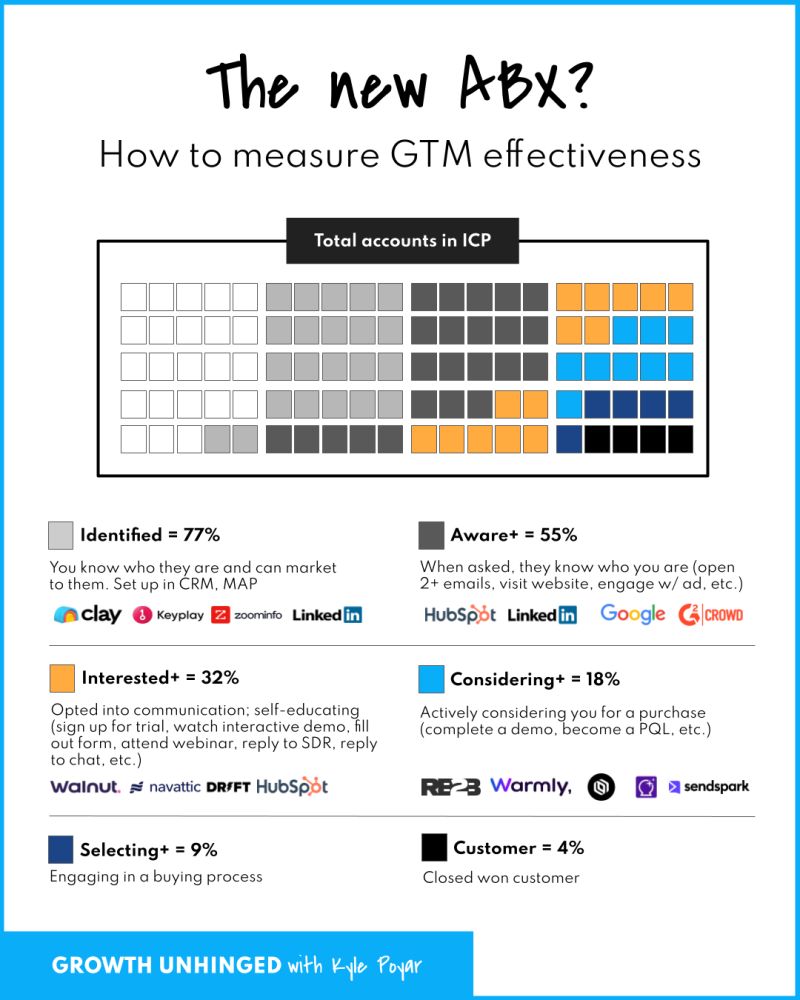
But yes, there were a few alterations and this is what their ABM campaign stages, finally, looked like:
Mistake 2: Using Contact-Level Attribution for ABM
If you rely on standard marketing attribution (which usually ties revenue to the last individual contact’s activity), ABM performance will look bleak.
This is especially true for ABM on LinkedIn where people don’t even click on ads but are nonetheless influenced by them:
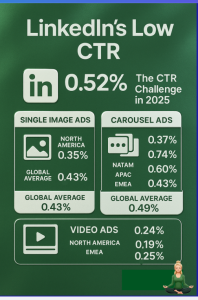
For example, Userpilot team found their CRM’s default model missed “pretty much all of our deals from ABM” because multiple influencers were involved. It gave lots of false negatives, under-crediting the campaign and killing internal support
Avoidance: Embrace account-level attribution. For instance, if you are running ads on LinkedIn, track account-level ad impressions, engagements and clicks.
ZenABM can help you with that. It pulls company-level ad engagement data for each campaign from LinkedIn’s official API:

By tracking impact on the account as a whole, you’ll see ABM’s real contribution.
Here’s a deeper guide on ABM ROI attribution.
Mistake 3: Buying Tools Before Nailing Strategy
Don’t hop on expensive ABM giants before fully realizing your strategy and needs in the first place.
The Userpilot team spent months evaluating tools, only to realize they didn’t need most of them.
Many ABM tools promise magic via proprietary ad networks or IP matching, but those can be unreliable (e.g. only ~11% of companies self-identify their IP, many buyers work remotely…)

In fact, Syft’s study found that web visitor identification tools’ accurcay tops at 42%:
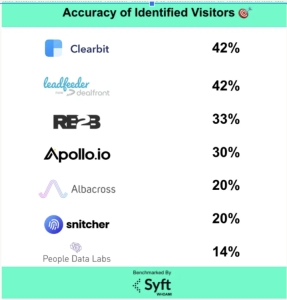
But Userpilot ended up spending on web visitor deanonymization tools in the beginning only to end up with just one reveal: themselves 🙁
Solution?
So, at this point Userpilot decided to ditch web visitor deanonymization altogether and go for LinkedIn ad viewer/clicker deanonymization.
They used only quantitative LinkedIn ad engagement for scoring, and leveraged qualitative intent (which ad they clicked) to inform BDR outreach.
Since LinkedIn’s native campaign manager lacked campaign-level company data, they built ZenABM (yes, that’s how ZenABM was born) to push both metrics:
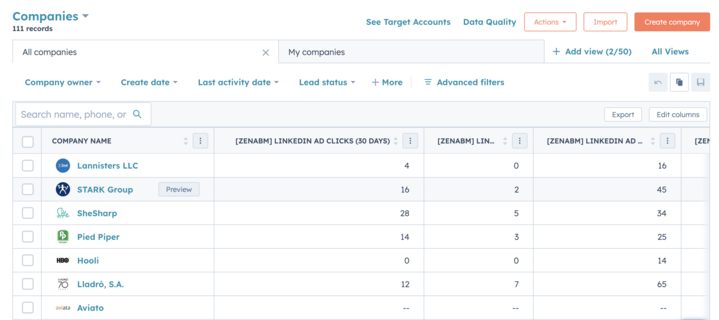
and intent tags to their CRM:
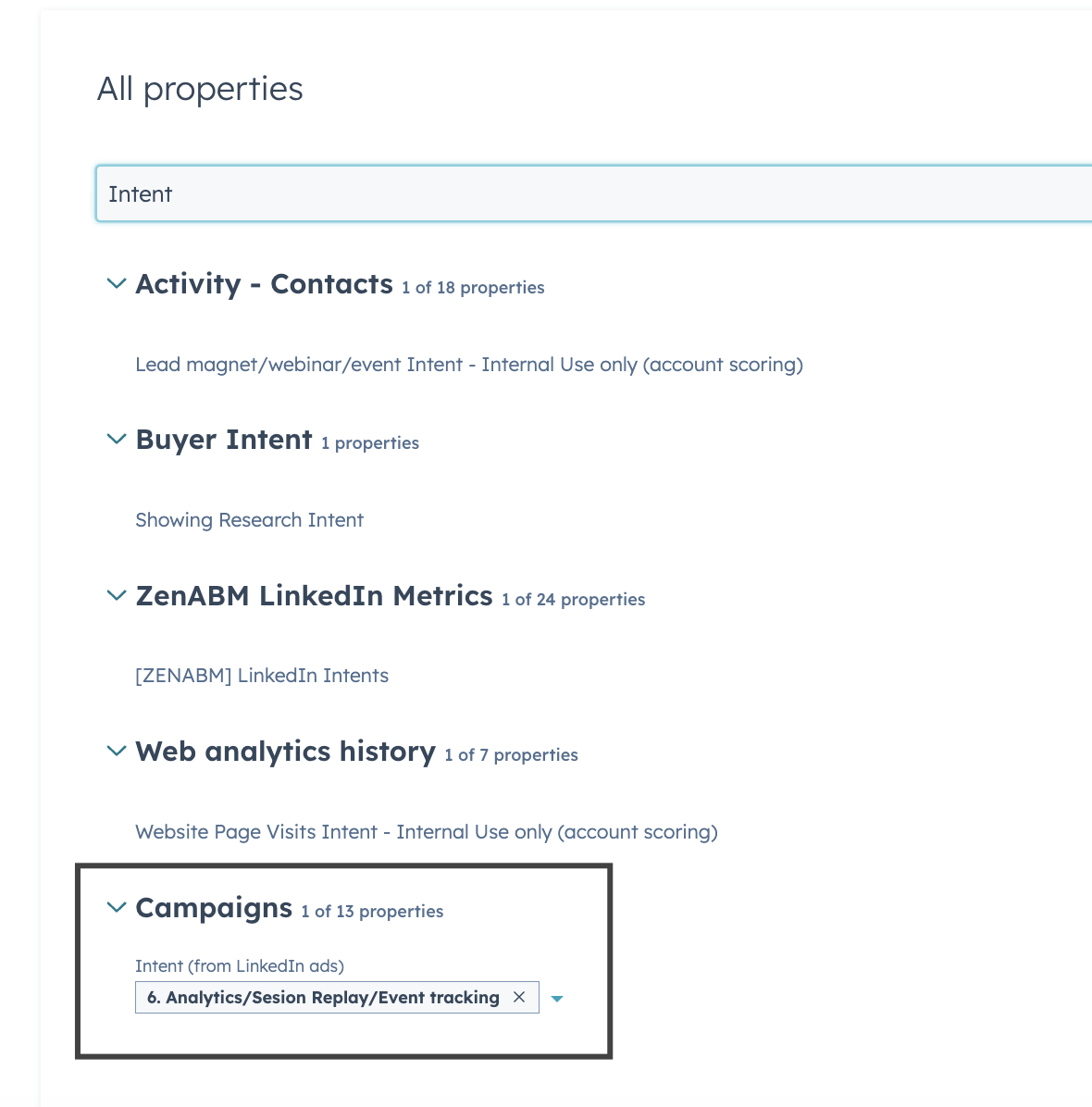
Mistake 4: Targeting Accounts with Nothing in Common
Some teams compile target lists that are all over the map – a few big logos, a few random sign-ups, a few companies someone met at an event.
The result is fragmented messaging that doesn’t resonate. If your targets don’t share key attributes, your campaign content will either be too generic or only relevant to a slice of the list.
To avoid this, define a unifying theme or criteria for each ABM campaign segment.
Like your ABM campaign can be focused on accounts with a common denominator, such as using a specific competitor’s software, having a similar tech stack, or showing interest in a particular product feature.
Mistake 5: Over-Segmenting Into Tiny Audiences
On the flip side of Mistake 4, you can slice the pie too thin.
It’s tempting to segment by industry, persona, intent level, funnel stage, all at once, to ultra-personalize.
But if you whittle audiences down to 20 people, your LinkedIn ads might not even serve (LinkedIn requires ~300, and you’ll gather zero meaningful data.
The Userpilot team learned this the hard way after chopping up their Total Addressable Market into minuscule segments. Like they couldn’t get 3+ clicks in many segments to analyze intent, and had to pivot from a persona-based campaign structure to an intent-first one:
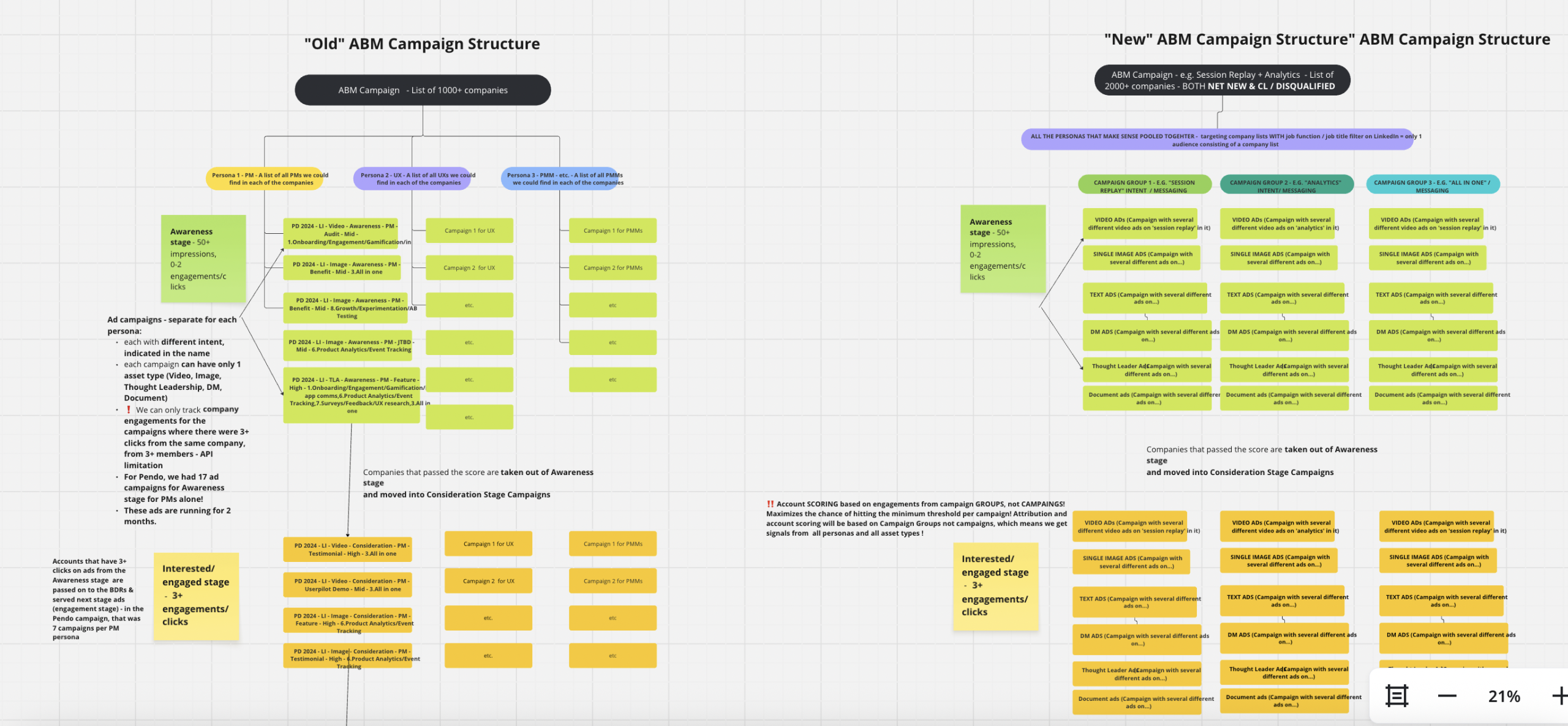
Mistake 6: Trying to Force Accounts Through a Funnel Stage By Stage
In reality, accounts don’t neatly move in unison through your predefined funnel.
If you show everyone only top-of-funnel ads for weeks, you might bore the ready-to-buy ones; if you push bottom-funnel too soon, you’ll confuse the unaware.
Avoidance: Mix it up. Especially early on, serve a variety of content like thought leadership, product offers, customer stories to all targets.
Let their responses tell you where they are. Once you see certain accounts clearly engaging (e.g. multiple people from Account A clicked product-demo ads), you can then funnel them into more bottom-of-funnel follow-ups.
Don’t rigidly program the journey on your timeline; let accounts self-educate at their pace.
Mistake 7: Treating BDR Outreach as Separate from Marketing
We’re back at the poiNt again: Your sales and marketing must be in lockstep for ABM to succeed.
But this alignment is not just about a mutually agreed TAL, but also about your BDRs knowing all about a prospect’s intent based on which ads they engaged with, so they can personalize their outreach.
Userpilot solved this by first making different ad campaigns for different intents (e.g. session replays, product analytics, etc.) and then pushing intent based on the ad the company engaged with as a company property into thier CRM using ZenABM:

Mistake 8: Burning Budget on Unqualified Retargeting
ABM often involves retargeting (showing ads to accounts that visited your site or engaged with content). But a naive approach is to retarget all website visitors from target accounts without filtering.
You could end up paying for clicks from random students or employees at giant companies outside your ICP just because they hit your site.
The fix?
Qualify your retargeting pool. For instance, run LinkedIn retargeting ads on a low-cost basis (e.g. text ads paid per click) just to identify which accounts are engaging.
Then de-anonymize those companies using ZenABM:
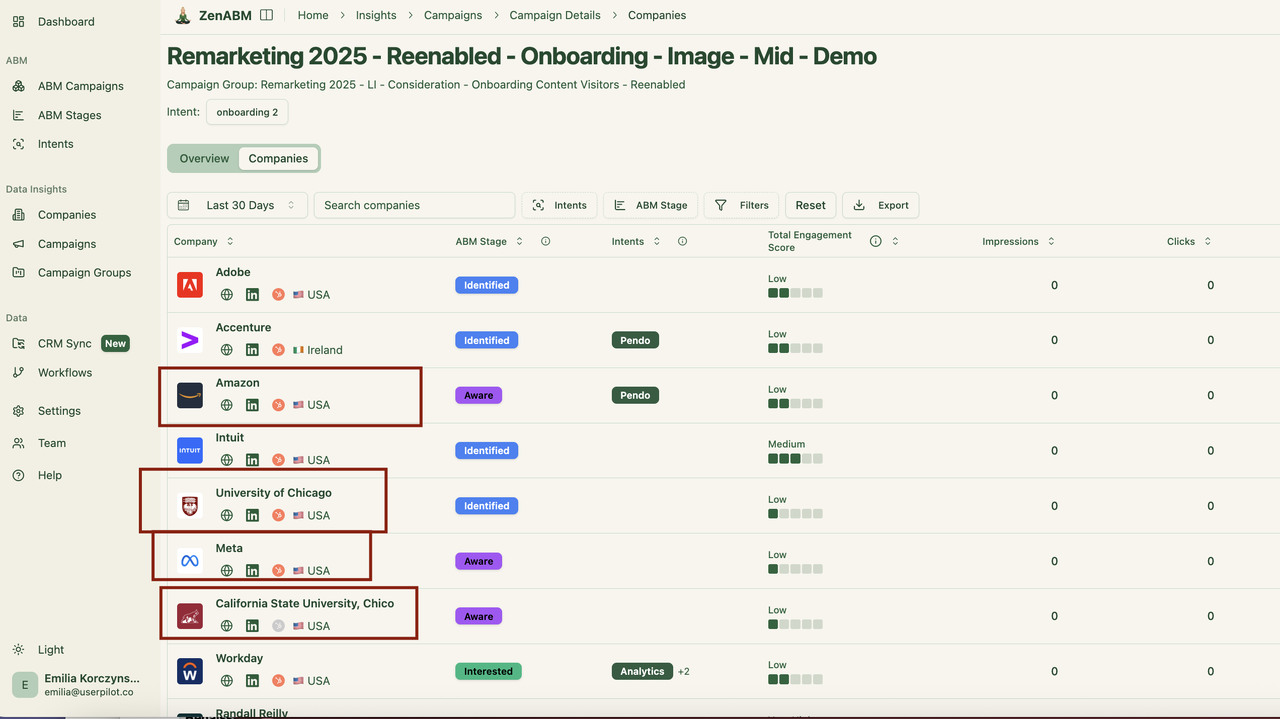
You can also just list out the accounts that engaged with your ads in a recent campaign but didn’t convert.
Then, exclude or remove the bad fits, and only then invest in higher-budget retargeting (like sponsored content) to the remaining list.
In short, use retargeting intelligently to nurture the right accounts, not just any visitor with a pulse.
ZenABM: A Must Have for ABM On LinkedIn
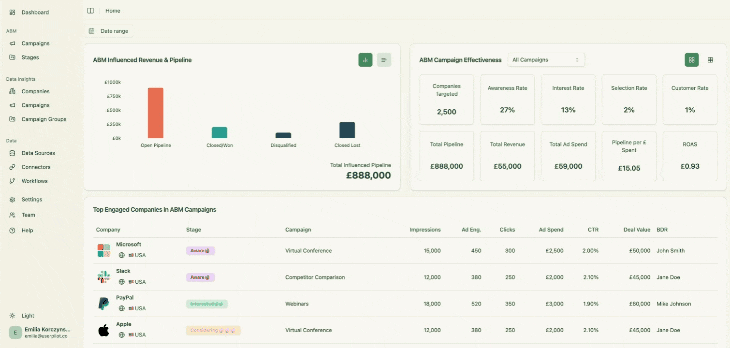
Companies like Userpilot have successfully implemented ZenABM in their ABM workflow.
But the use cases and capabilities span a wide range.
Here’s a closer look at what ZenABM offers:
Track Company-Level LinkedIn Ad Engagement per Campaign
ZenABM retrieves data like clicks, impressions, and other interactions for each ad, segmented by company, directly from LinkedIn’s official ads API.
You can evaluate how each campaign is performing:
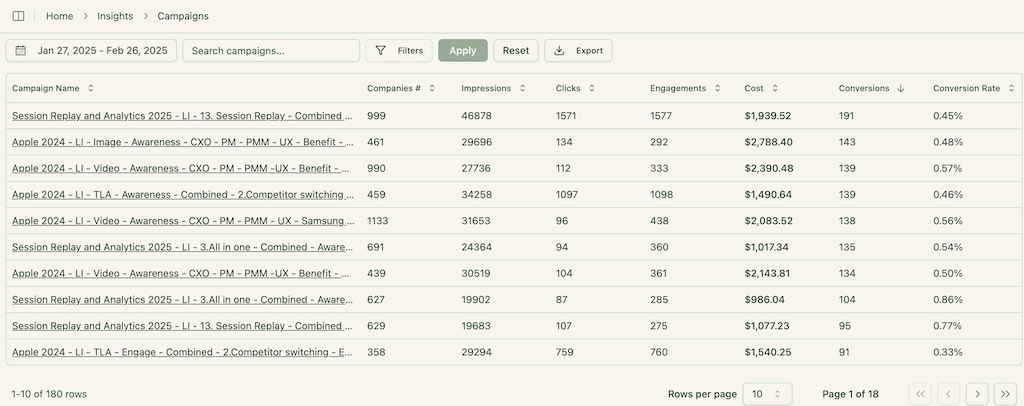
And identify which companies interacted with specific campaigns:

Automatically Push LinkedIn Ad Engagement to Your CRM

ZenABM regularly syncs company-level engagement metrics into your CRM as custom company properties.
Pipeline and Revenue Attribution
ZenABM links the companies engaging with your ads to those present in your CRM deals. This gives you a clear view of how ads influence sales outcomes:
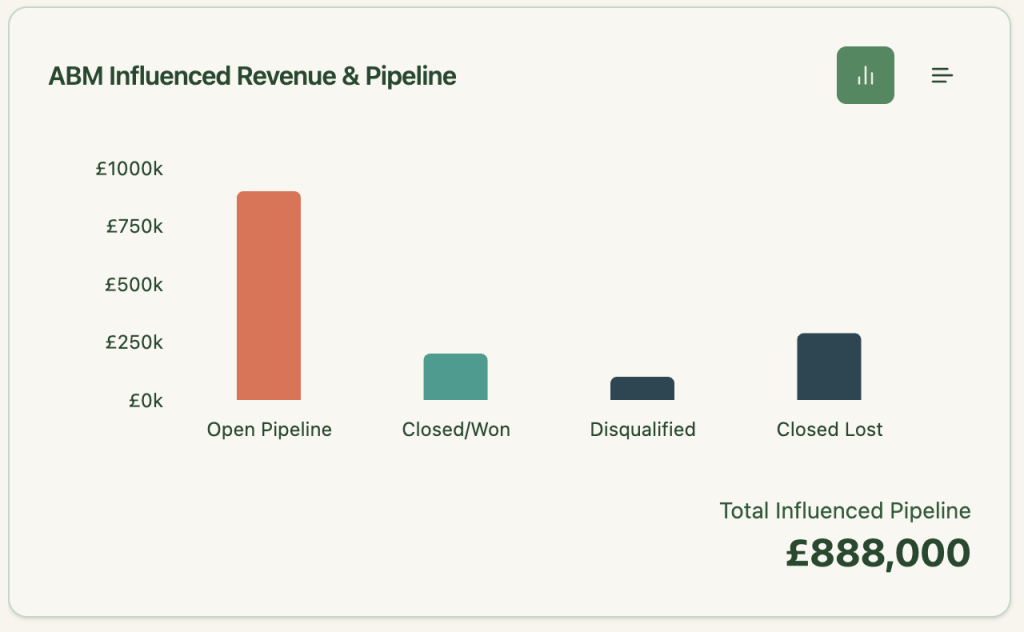
Out-of-the-Box ABM Analytics Dashboards
With deal-level attribution, ZenABM powers detailed dashboards to help you measure success.
You’ll find stats like ROAS, total ad spend, pipeline generated, revenue influenced, and more.

Engagement Scoring and Intelligent BDR Routing
ZenABM assigns each account an “Engagement Score” in real time:

It also identifies the ABM stage of each company:

Then assigns high-interest companies to your BDRs inside the CRM:

It even groups accounts by intent signals and behavior:
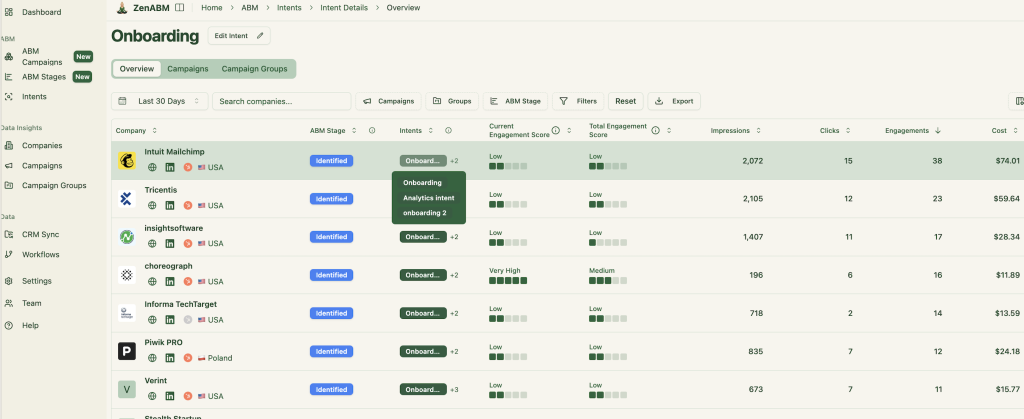
This intent data is pushed to your CRM:
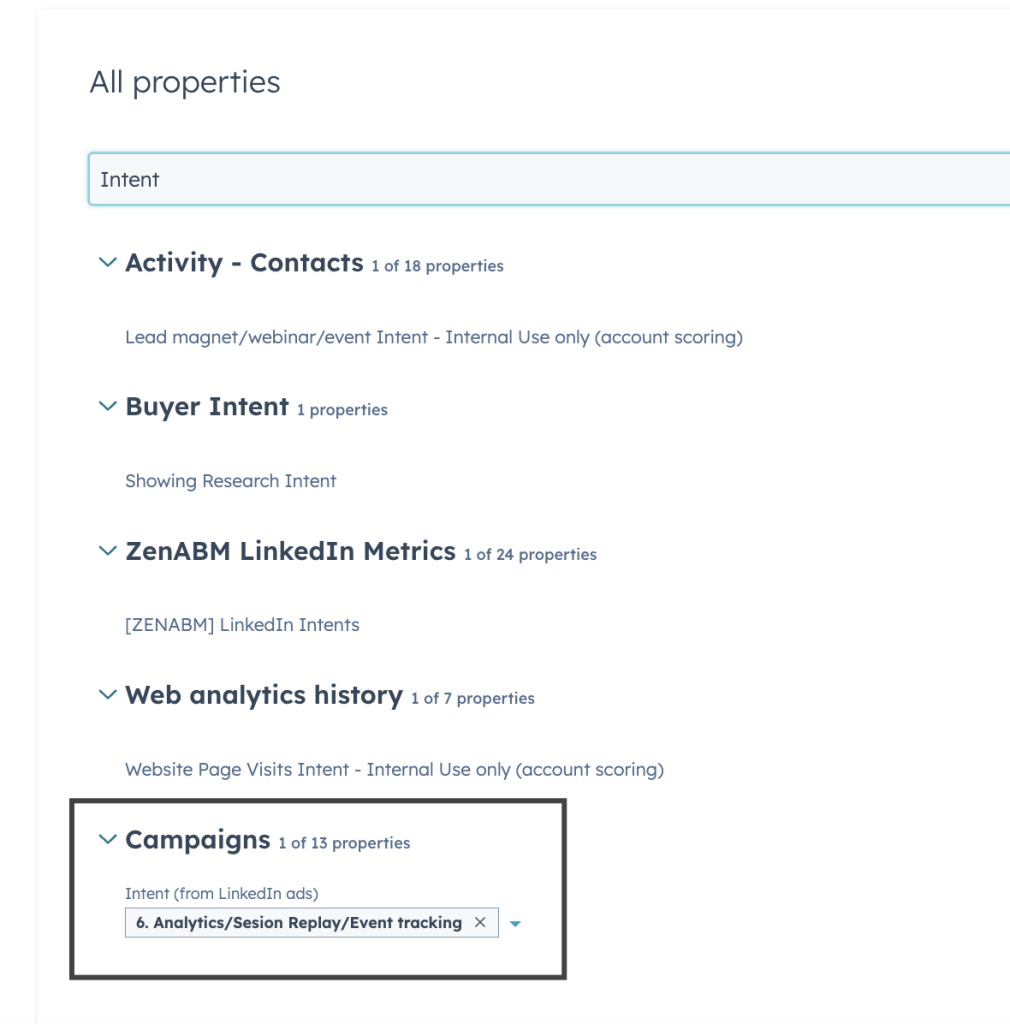
Your sales reps now not only know which companies to prioritize, but also understand what those companies’ intent is.
Pre-Built ABM Data Models
Since most ABM programs, like Userpilot’s, include campaign groups and sub-campaigns, ZenABM simplifies your setup with structured ABM objects such as campaign groups, campaigns, and ads.
ABM Stage Visibility with Custom Thresholds and Leak Analysis
ZenABM tracks each company’s progress using their engagement score. You can customize the thresholds that define each ABM stage:
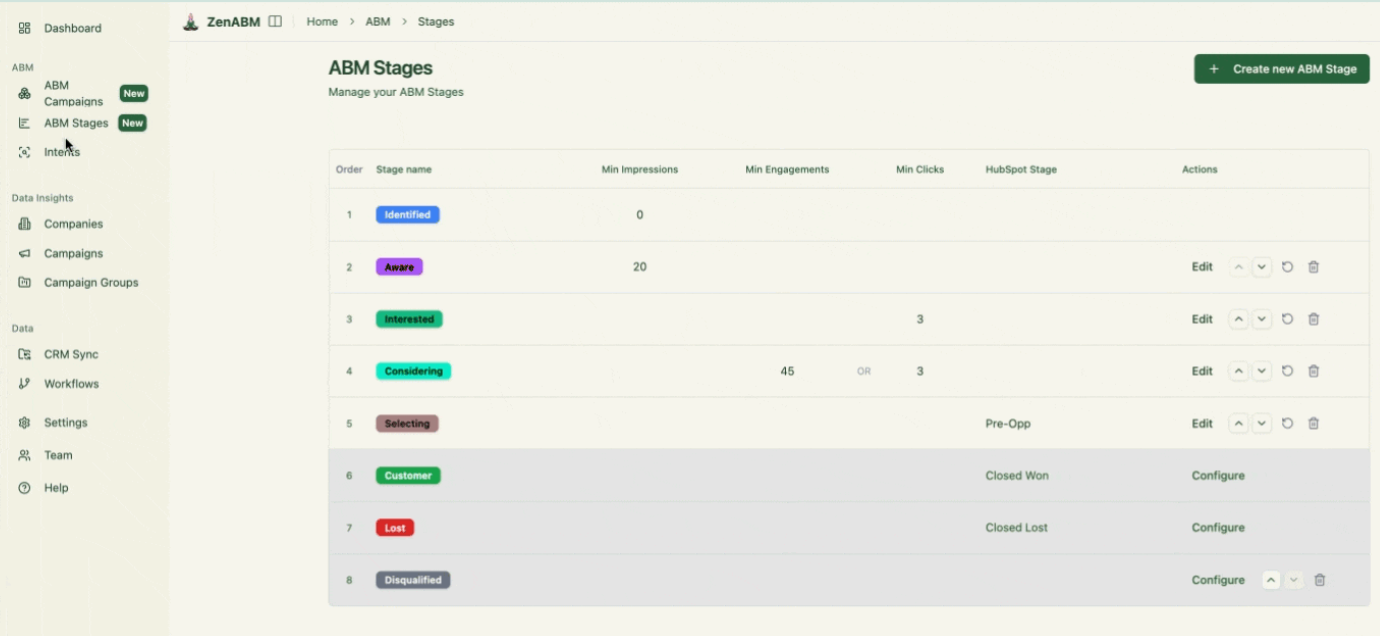
It also shows how many accounts move from one stage to the next:
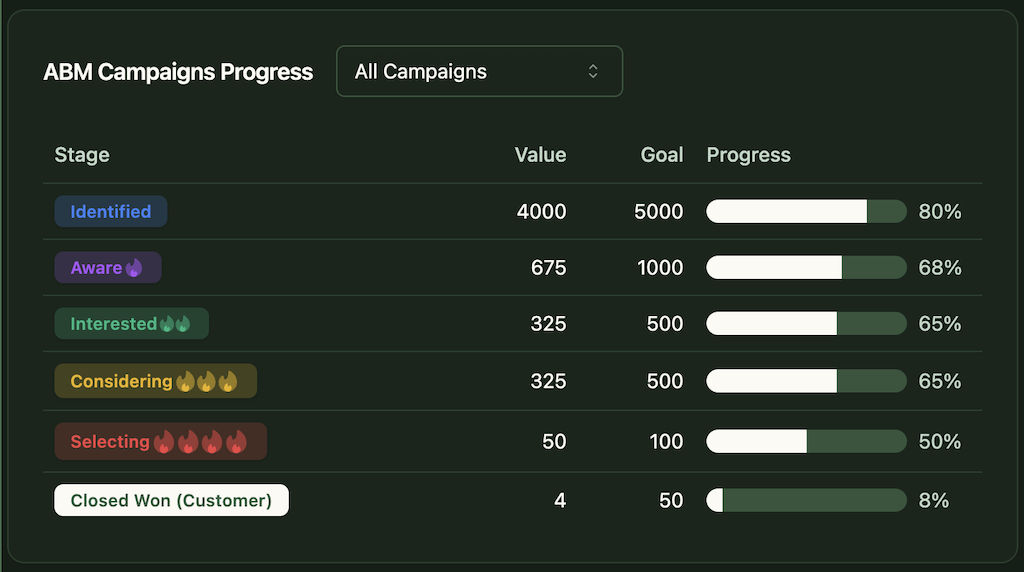
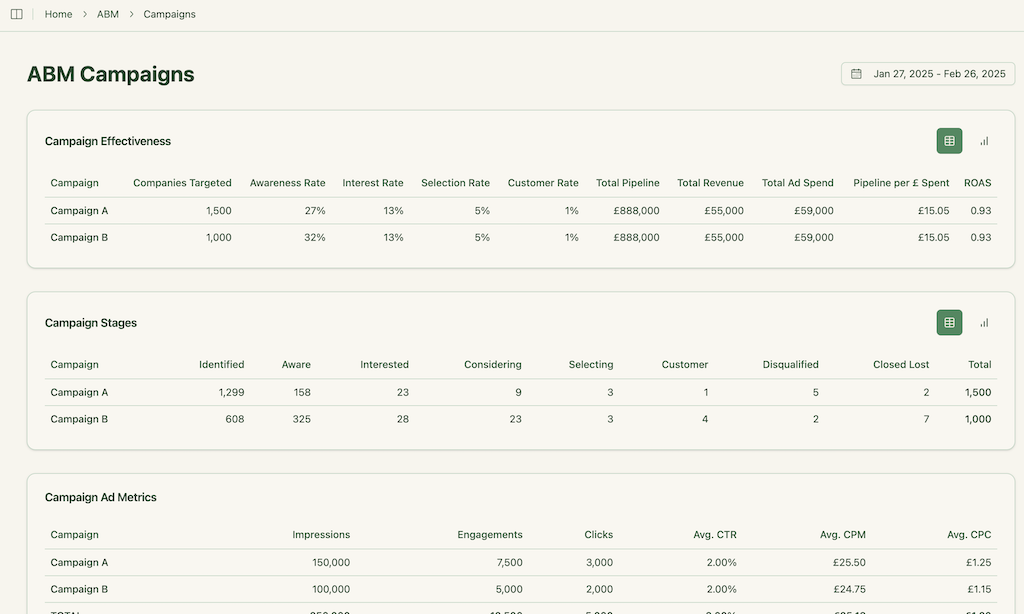
These insights help you detect where engagement is stalling. For example, if many companies reach the ‘Interested’ phase but don’t convert, it might be time to improve your outreach.
ZenABM Pricing

Choose the plan that fits your ABM needs:
- Starter – $59/month: Includes 1 campaign, basic scoring, HubSpot integration, and campaign intent.
- Growth – $75/month: Adds BDR routing, real-time alerts, and expanded dashboards.
- Pro – $119/month: Unlimited campaigns, in-depth analytics, and upcoming automation features.
Try ZenABM for free or book a live demo.
What is an ABM Strategy: Final Thoughts
ABM isn’t just another tactic. It’s a mindset shift: one that prioritizes strategic focus, deep personalization, and tight sales-marketing alignment over vanity metrics and spray-and-pray lead gen.
In today’s B2B world where multiple stakeholders influence a deal and buyer journeys are longer and more complex, ABM is how you break through the noise.
But doing ABM right requires discipline: targeting the right accounts, aligning teams, creating relevant content across channels, and measuring what actually moves revenue.
And when it comes to executing ABM on LinkedIn, ZenABM fills the exact gaps most tools miss—from company-level engagement tracking and CRM sync to sales routing and revenue attribution.
So whether you’re just starting out or optimizing a mature ABM program, one thing’s clear:
ABM done right delivers bigger deals, better ROI, and tighter GTM focus.
And with the right strategy, and the right tools. You won’t just run campaigns. You’ll win accounts.

